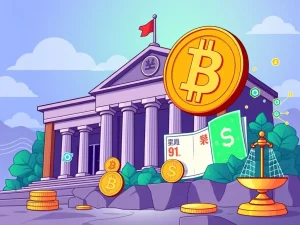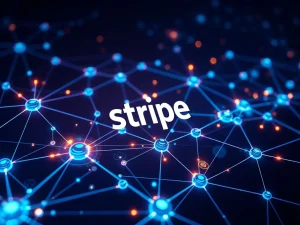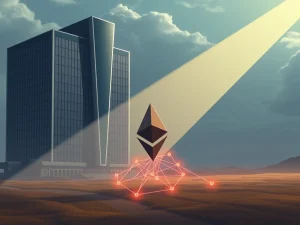Unlock Superior Value: Why Tokenized Gold Beats Gold ETFs Amid Market Uncertainty

Amidst growing macroeconomic uncertainty and geopolitical tensions, investors are increasingly turning to gold as a safe-haven asset. While traditional avenues like gold ETFs exist, a new digital alternative, tokenized gold, is gaining traction. But what makes digital gold tokens a potentially superior choice compared to paper-based alternatives like gold ETFs? Representatives from Gold DAO, an organization focused on facilitating access to tokenized gold, shed light on the distinct advantages.
Tokenized Gold vs. Gold ETFs: What’s the Key Difference?
According to Melissa Song and Dustin Becker of Gold DAO, the fundamental difference lies in ownership and redeemability. When you buy a share in a gold ETF, you typically own a share of a trust or fund that holds gold, not a claim on a specific physical gold bar. As Song explained, “When you buy an ETF, you are betting on the gold price going up, but you do not own any specific gold bar.”
In contrast, tokenized gold, particularly models like those facilitated by Gold DAO, often represents a direct, verifiable claim on a specific quantity of physical, serialized gold. This direct link to the underlying physical asset is a crucial distinction for investors seeking tangible backing for their investment.
Unlocking the Benefits of Tokenized Gold
Gold DAO representatives highlighted three primary benefits that set tokenized gold apart:
- 1:1 Redeemability for Physical Gold: A core advantage is the ability to redeem your tokens for a specific quantity of the underlying physical gold. This provides investors with direct access to the tangible asset, bypassing the potential complexities or limitations associated with redeeming shares in a traditional gold ETF for physical metal. Each token often corresponds to a specific amount of gold, offering clear ownership rights to a physical asset.
- Utility in Decentralized Finance (DeFi): Tokenized gold brings a historically stable asset class onto the blockchain, opening up new possibilities within decentralized finance. Unlike traditional paper gold holdings, tokenized gold can be used as collateral for loans, traded on decentralized exchanges, or integrated into various DeFi protocols, providing yield-generating opportunities that are not typically available with physical gold or ETF shares. This integration into the digital economy enhances liquidity and utility.
- Transactional Efficiency and Liquidity: Trading tokenized gold on blockchain networks offers significant efficiency. Transactions can occur 24/7, often with lower fees and faster settlement times compared to traditional markets. The digital nature allows for fractional ownership and easy transferability, contributing to on-demand liquidity and accessibility for a wider range of investors. This contrasts with the often slower, more rigid processes of traditional gold markets or redeeming physical gold.
Macroeconomic Forces Driving Gold’s Appeal
The current global economic climate is a major factor pushing investors towards safe-haven assets like gold. High levels of US government debt, ongoing geopolitical tensions reshaping the global monetary order, and trade disputes (such as the tariffs announced by US President Donald Trump in April 2025, which caused turmoil in risk-on markets) have all contributed to significant market volatility.
This uncertainty has propelled the gold price to all-time highs against the US dollar, reaching $3,500 per ounce in April 2025. The Volatility S&P Index (VIX) also surged following trade policy announcements, reflecting the increased market fear and the flight to safety. This environment makes assets with inherent value and stability, like gold, particularly attractive.
Real-World Assets (RWAs) on the Blockchain
Tokenized gold is a prime example of bringing real-world assets onto the blockchain. This trend allows investors to access tangible assets, traditionally held off-chain, with the benefits of blockchain technology – transparency, divisibility, and liquidity. The tokenization of gold represents a significant step in bridging the gap between traditional finance and the digital asset space, making assets like gold more accessible and usable in innovative ways, particularly within the growing DeFi ecosystem.
The Role of Gold-Backed Tokens in the Digital Economy
The surge in the gold price has also boosted the appeal of existing gold-backed cryptocurrencies like Paxos Gold (PAXG) and Tether Gold (XAUT). These tokens, which aim to maintain a price pegged to gold, offer investors a way to hold gold exposure within their digital asset portfolios.
Prominent Bitcoin advocate Max Keiser has argued that gold-backed tokens could even outcompete fiat stablecoins. He suggests that a stablecoin backed by gold offers superior resistance to inflation and geopolitical risk compared to those backed by fiat currencies like the US dollar, which face guaranteed loss of purchasing power over time. This perspective highlights the potential for gold-backed tokens to play a significant role in future global monetary systems, especially in regions seeking alternatives to dollar-pegged assets.
Summary: Why Tokenized Gold Stands Out
In conclusion, while traditional gold ETFs offer exposure to the gold price, tokenized gold provides a potentially more robust and versatile alternative. Its key advantages include direct 1:1 redeemability for physical gold, seamless integration and utility within decentralized finance applications, and enhanced transactional efficiency. Amidst current macroeconomic volatility and rising gold price, tokenized gold represents an evolution in how investors can access and utilize this timeless store of value, leveraging blockchain technology to unlock new possibilities for real-world assets.
This article does not contain investment advice or recommendations. Every investment and trading move involves risk, and readers should conduct their own research when making a decision.









